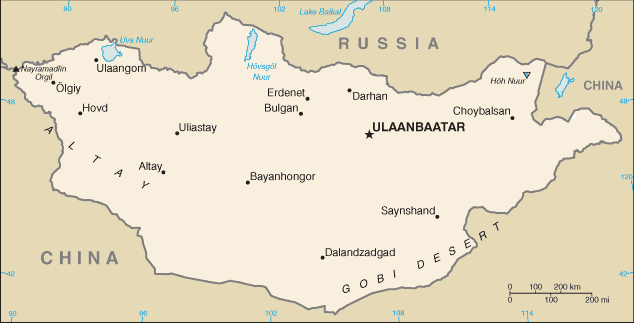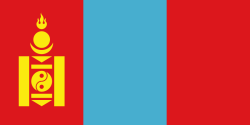Mongolia
Related Categories:
 Soyombo script - omniglot.com
Soyombo script - omniglot.comThe Soyombo script was designed to write Mongolian, Sanskrit and Tibetan and for transcribing foreign words.
www.omniglot.com/
The soyombo (or soyemba) is the national emblem of Mongolia. Its origins are closely associated with Lamaism, and the various elements of the design were regarded as having mystical meanings.
www.fotw.us/flags/mn.html Mongolia - wikipedia.org
Mongolia was the center of the Mongol Empire in the thirteenth century and was later ruled by the Qing Dynasty from the end of the seventeenth century until 1911, when an independent government was formed with Russian assistance.
en.wikipedia.org/
Life in sparsely populated Mongolia has recently become more urbanized. Nearly half of the people live in the capital, Ulaanbaatar, and in other provincial centers. Semi-nomadic life still predominates in the countryside, but settled agricultural communities are becoming more common. Mongolia's birth rate is estimated at 19 births/1000 people (2006). About two-thirds of the total population is under age 30, 28.5% of whom are under 14.
Ethnic Mongols account for about 85% of Mongolia's population and consist of Khalkha and other groups, all distinguished primarily by dialects of the Mongol language. Mongol is an Altaic language--from the Altaic Mountains of Central Asia, a language family comprising the Turkic, Tungusic, and Mongolic subfamilies--and is related to Turkic (Uzbek, Turkish, and Kazakh), Korean, and, possibly, Japanese. Among ethnic Mongols, the Khalkha comprise 90% and the remaining 10% include Durbet Mongols in the north and Dariganga Mongols in the east. Turkic speakers (Kazakhs, Turvins, and Khotans) constitute 7% of Mongolia's population, and the rest are Tungusic-speakers, Chinese, and Russians. Most Russians left the country following the withdrawal of economic aid and collapse of the Soviet Union in 1991.
Traditionally, Tibetan Buddhist Lamaism was the predominant religion. However, it was suppressed under the communist regime until 1990, with only one showcase monastery allowed to remain. Since 1990, as liberalization began, Buddhism has enjoyed a resurgence. About 4 million ethnic Mongols live outside Mongolia; about 3.4 million live in China, mainly in the Inner Mongolia Autonomous Region, and some 500,000 live in Russia, primarily in Buryatia and Kalmykia.
www.state.gov/r/
Introduction
About
Contact
Symbols in The News
Interpret this Symbol
AAC
African
AI
Alchemy
Alphabets
Ancient
Animal Symbolism
Architecture
Art
Articles
Astrology
Baha'i
Blissymbolics
Blueprint Symbols
Buddhist
Celtic Symbols
Cemetery
Chinese Symbols
Christian
Circle
City
Codes
Color
Conlangs
Crop Circles
Danger
Da Vinci Code
Designing Logos
Dictionaries
Dreams
Education
Egyptian Symbols
Electrical
Emoticons
Find Images
Fonts
Food
Fraternity
Hamsa
Healing
Heraldry
Hermetic
Highway Signs
Hindu
History
Hobo
Holiday
Icons
iConji
Islamic
Jain Symbols
Japanese, Kanji
Jewish
Justice
Law
Literary Symbolism
Mandalas
Map
Masonic
Math, Number
Meaning of Names
Medical
Middle East
Military
Miscellaneous
Money
Music
Mythology
Native American
Playing Cards
Power
Psychology
QiQiiKhu
Reiki
Religious
Runes, Norse
Sacred Geometry
Scientific
Science Fiction
Sorority
Sports
Symbols in the News
Tattoos
ThirteenSymbols
Tree of Life
Ursprache
Videos
Visual Languages
Weather
Web Codes
Wicca
Words
Writing Systems
Braille
Coinherence
Coptic
Cuneiform
Easter Island
Etruscan
Happy Human
Hebrew
Kokopelli
Linear B
Lotus
Love Symbols
Mandorla
Moon Alphabet
Nine Pointed Star
Om
Oz
Phonetic
Scarab Beetle
Silent
Theosophy
Unifon
About
Contact
Symbols in The News
Interpret this Symbol
AAC
African
AI
Alchemy
Alphabets
Ancient
Animal Symbolism
Architecture
Art
Articles
Astrology
Baha'i
Blissymbolics
Blueprint Symbols
Buddhist
Celtic Symbols
Cemetery
Chinese Symbols
Christian
Circle
City
Codes
Color
Conlangs
Crop Circles
Danger
Da Vinci Code
Designing Logos
Dictionaries
Dreams
Education
Egyptian Symbols
Electrical
Emoticons
Find Images
Fonts
Food
Fraternity
Hamsa
Healing
Heraldry
Hermetic
Highway Signs
Hindu
History
Hobo
Holiday
Icons
iConji
Islamic
Jain Symbols
Japanese, Kanji
Jewish
Justice
Law
Literary Symbolism
Mandalas
Map
Masonic
Math, Number
Meaning of Names
Medical
Middle East
Military
Miscellaneous
Money
Music
Mythology
Native American
Playing Cards
Power
Psychology
QiQiiKhu
Reiki
Religious
Runes, Norse
Sacred Geometry
Scientific
Science Fiction
Sorority
Sports
Symbols in the News
Tattoos
ThirteenSymbols
Tree of Life
Ursprache
Videos
Visual Languages
Weather
Web Codes
Wicca
Words
Writing Systems
Braille
Coinherence
Coptic
Cuneiform
Easter Island
Etruscan
Happy Human
Hebrew
Kokopelli
Linear B
Lotus
Love Symbols
Mandorla
Moon Alphabet
Nine Pointed Star
Om
Oz
Phonetic
Scarab Beetle
Silent
Theosophy
Unifon

